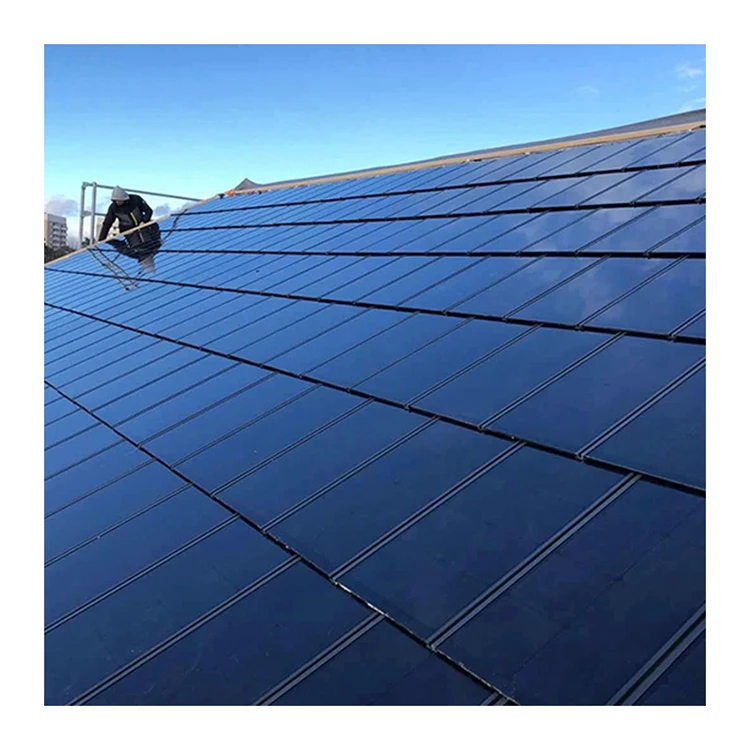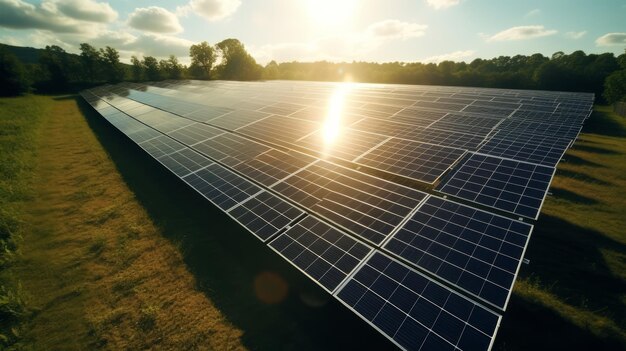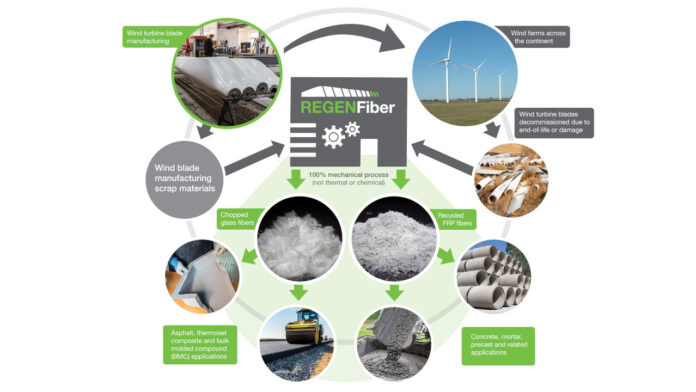
Solar Roof Tiles: Integrating Clean Energy Seamlessly – Your Guide to a Beautiful, Sustainable Home
Imagine a roof that not only shelters your home but also silently powers it, blending so perfectly with your home’s design that you’d barely know it’s there. Welcome to the world of solar roof tiles – a revolutionary step in clean energy that combines cutting-edge technology with elegant aesthetics.
For years, traditional solar panels have been a beacon of renewable energy, but their bulky appearance isn’t always everyone’s cup of tea. Solar roof tiles, however, offer a discreet yet powerful alternative, seamlessly integrating into your home’s architecture while harnessing the sun’s abundant energy.
In this comprehensive guide, we’ll dive deep into what solar roof tiles are, how they work, their numerous benefits, and everything you need to consider before making the switch to this innovative energy solution. Get ready to discover how you can transform your home into an energy-independent sanctuary, all while boosting its beauty and value.
What Exactly Are Solar Roof Tiles? The Basics Explained
At its core, a solar roof tile (also known as a solar shingle, solar slate, or integrated solar roof) is a roofing material designed to look like traditional tiles or shingles, but with a hidden superpower: the ability to generate electricity from sunlight.
Unlike conventional solar panels, which are mounted on top of an existing roof, solar roof tiles are the roof. They replace standard roofing materials entirely, creating a unified, sleek, and often more aesthetically pleasing appearance.
Think of it this way:
- Traditional Solar Panels: A separate system placed on your existing roof.
- Solar Roof Tiles: Your actual roof is the solar system.
These innovative tiles come in various styles, colors, and materials, mimicking everything from classic asphalt shingles and terracotta tiles to modern slate and wood shakes. This versatility ensures they can complement almost any home design, making sustainable living more accessible and visually appealing than ever before.
How Do Solar Roof Tiles Work? Powering Your Home, Tile by Tile
The science behind solar roof tiles is similar to that of traditional solar panels, just packaged differently. Here’s a simplified breakdown:
- Sunlight Absorption: Each solar roof tile contains tiny photovoltaic (PV) cells. When sunlight (photons) hits these cells, it excites the electrons within the semiconductor material (usually silicon).
- Creating DC Electricity: This movement of electrons generates a direct current (DC) electricity.
- Inversion to AC: Homes and the electrical grid use alternating current (AC) electricity. So, the DC electricity from the tiles flows to an inverter (or a series of micro-inverters located near each tile). The inverter’s job is to convert the DC electricity into usable AC electricity.
- Powering Your Home: The converted AC electricity then flows into your home’s electrical panel, powering your lights, appliances, and electronics.
- Grid Connection (Net Metering): If your solar roof generates more electricity than your home is currently using, the excess power is sent back to the main electrical grid. Through a process called net metering, your utility company credits you for this excess energy, which can significantly lower your electricity bills or even result in a credit on your account. When your solar roof isn’t producing enough power (e.g., at night or on very cloudy days), your home simply draws electricity from the grid as usual.
This seamless integration means your home can be largely self-sufficient during the day, reducing your reliance on traditional power sources and lowering your carbon footprint.
Why Choose Solar Roof Tiles? Unlocking a World of Benefits
The appeal of solar roof tiles goes far beyond just generating electricity. They offer a compelling suite of advantages that make them a smart choice for modern homeowners.
1. Unmatched Aesthetics & Curb Appeal
- Invisible Energy: This is arguably the biggest draw. Solar tiles are designed to blend seamlessly with your roof, providing a sleek, uniform look that traditional panels can’t match. No bulky racks or visible wiring.
- Design Versatility: Available in various styles, colors, and textures (e.g., mimicking slate, asphalt, or terracotta), they maintain your home’s architectural integrity and often enhance its visual appeal.
- Increased Property Value: A beautiful, energy-independent home is highly desirable. Solar roof tiles can significantly boost your property’s market value, making it more attractive to potential buyers.
2. Energy Independence & Significant Savings
- Lower Electricity Bills: By generating your own power, you drastically reduce or even eliminate your monthly electricity expenses.
- Protection Against Rising Rates: You become less vulnerable to fluctuating energy prices, providing long-term financial stability.
- Potential for Net Metering Credits: Sell excess energy back to the grid and receive credits from your utility company.
3. Durability & Longevity
- Built to Last: Solar roof tiles are engineered to be extremely robust, designed to withstand harsh weather conditions like high winds, heavy rain, hail, and snow. Many come with impressive warranties (often 25-30 years or more) that cover both power output and the integrity of the roofing material itself.
- Integrated Protection: Because they are the roof, they often provide superior protection against leaks and structural issues compared to panels installed over an existing roof.
4. Environmental Impact & Sustainability
- Reduced Carbon Footprint: By using clean, renewable solar energy, you significantly decrease your reliance on fossil fuels, directly contributing to lower greenhouse gas emissions.
- Promote Green Living: You become a part of the solution to climate change, setting an example for sustainable practices in your community.
- Resource Conservation: Harnessing solar energy helps conserve finite natural resources.
5. Enhanced Safety & Efficiency
- Fire Resistance: Many solar roof tiles have excellent fire ratings (Class A), often surpassing traditional roofing materials.
- Wind Resistance: Their integrated design makes them less susceptible to wind damage compared to elevated solar panels.
- Improved Efficiency: While early versions had lower efficiency, modern solar roof tiles are constantly improving, with some brands offering efficiency levels comparable to traditional panels.
- Smart Home Integration: Many systems can be monitored via smartphone apps, allowing you to track energy production, consumption, and even battery storage in real-time.
Solar Roof Tiles vs. Traditional Solar Panels: A Head-to-Head Comparison
Choosing between solar roof tiles and traditional solar panels often comes down to priorities: aesthetics vs. initial cost. Here’s a quick comparison to help you weigh your options:
| Feature | Solar Roof Tiles (Integrated) | Traditional Solar Panels (Mounted) |
|---|---|---|
| Appearance | Seamless, blends into roof design, highly aesthetic. | Visible, mounted on top of roof, can be bulky. |
| Installation | Replaces existing roof, more complex, often requires roofing and electrical expertise. | Mounted on existing roof, generally quicker to install if roof is sound. |
| Initial Cost | Generally higher, as it combines roofing and solar. | Lower initial cost, as it’s an add-on. |
| Durability | Often integrated into the roof structure, very durable, excellent weather resistance. | Durable, but can be more susceptible to wind uplift if not installed perfectly. |
| Roof Condition | Ideal for new roof installations or complete roof replacements. | Can be installed on existing, structurally sound roofs. |
| Efficiency | Improving rapidly, can be slightly lower than top-tier panels due to smaller surface area per unit. | Generally high efficiency, maximizing power output per square foot. |
| Maintenance | Low maintenance, similar to a regular roof, self-cleaning. | Low maintenance, occasional cleaning might be needed. |
| Resale Value | High, as it’s seen as a premium, integrated upgrade. | Good, but aesthetic impact can vary. |
When to choose Solar Roof Tiles:
- You are planning a new roof installation or a complete roof replacement.
- Aesthetics and maintaining your home’s architectural style are top priorities.
- You want a truly integrated, future-proof energy solution.
- You are looking for long-term value and durability.
When to choose Traditional Solar Panels:
- Your existing roof is relatively new and in excellent condition.
- Your budget for the initial investment is a primary concern.
- You prioritize maximum energy output per square foot over aesthetics.
- You might want the option to remove or upgrade the solar system more easily in the future.
Key Considerations Before Installation: Making an Informed Decision
Investing in a solar roof is a significant decision. Here are the crucial factors to consider before you take the plunge:
1. Cost & Budget
- Upfront Investment: Solar roof tiles typically have a higher initial cost than traditional solar panels because you’re essentially getting a new roof and a solar system in one. Prices vary widely based on roof size, complexity, tile type, and brand.
- Long-Term Savings: While the upfront cost is higher, remember the long-term savings on electricity bills, increased property value, and potential government incentives that offset the investment over time.
2. Your Roof’s Suitability
- Age & Condition: Solar roof tiles are best suited for new construction or homes requiring a complete roof replacement. Installing them on an old or damaged roof is counterproductive.
- Sunlight Exposure: Like all solar systems, optimal performance depends on sunlight. Your roof should have minimal shading from trees, chimneys, or neighboring buildings, especially during peak sun hours (9 AM – 3 PM). South-facing roofs are ideal, but east and west-facing roofs can also be effective.
- Roof Pitch & Size: The angle and size of your roof will impact how many tiles can be installed and how much energy they can generate.
3. Finding the Right Installer
- Experience Matters: Choose a solar roofing company with a proven track record specifically in solar tile installations. This is a specialized field.
- Certifications & Licenses: Ensure they are licensed, insured, and have certified installers. Look for certifications from organizations like NABCEP (North American Board of Certified Energy Practitioners).
- References & Reviews: Ask for customer references and check online reviews.
- Comprehensive Quote: Get detailed quotes that include all costs: materials, labor, permits, interconnection fees, and warranty information.
4. Permits & Regulations
- Local Requirements: Solar installations require various permits (building, electrical, zoning). Your installer should handle this process, but be aware of the requirements in your area.
- Homeowner Association (HOA) Rules: If you live in an HOA, check their rules regarding solar installations. Many states have "solar rights" laws that limit an HOA’s ability to prohibit solar, but it’s good to be informed.
5. Warranties & Maintenance
- Product Warranty: Covers the integrity of the tile itself and its ability to withstand weather.
- Performance Warranty: Guarantees a certain level of power output over time (e.g., 90% after 10 years, 80% after 25 years).
- Workmanship Warranty: Covers the installation work.
- Maintenance: Solar roofs are generally low maintenance. Rain usually washes away most debris. Occasional checks for blockages or damage are recommended, similar to a regular roof.
The Installation Process: What to Expect
While complex for the professionals, the installation process for solar roof tiles typically follows these general steps:
- Assessment & Design: A solar professional will inspect your roof, assess its suitability, and design a custom system that maximizes energy production for your home’s needs.
- Permitting: The installer will handle obtaining all necessary local permits.
- Old Roof Removal (if applicable): If you’re replacing an existing roof, the old roofing material will be removed.
- Underlayment Installation: A waterproof underlayment is installed to protect your home.
- Solar Tile Installation: The solar roof tiles are installed, often interlocking or overlapping like traditional shingles, ensuring a watertight seal. The electrical connections are made as they are laid.
- Inverter & Electrical Wiring: The inverter is installed, and the electrical wiring connects the solar tiles to your home’s electrical panel.
- System Activation & Inspection: Once installed, the system undergoes thorough testing and local electrical inspections before being connected to the utility grid.
- Monitoring Setup: Your installer will set up your system monitoring, allowing you to track your energy production and consumption.
Financial Incentives & Return on Investment (ROI)
The upfront cost of solar roof tiles can be significant, but various financial incentives can make them more affordable and boost your return on investment.
1. Federal Solar Tax Credit (ITC)
- The Investment Tax Credit (ITC), also known as the federal solar tax credit, is a major incentive. It allows you to deduct a percentage of the cost of your solar system (including solar roof tiles) from your federal taxes. As of early 2024, this credit is 30% for systems placed in service through 2032. This is a dollar-for-dollar reduction in your tax liability.
2. State & Local Incentives
- Many states, counties, and even cities offer additional incentives, such as:
- Rebates: Direct payments or discounts on your solar system.
- Performance-Based Incentives (PBIs): Payments based on the amount of electricity your system produces (e.g., SRECs – Solar Renewable Energy Credits).
- Property Tax Exemptions: Exempting the added value of the solar system from property tax assessments.
- Sales Tax Exemptions: Waiving sales tax on solar equipment.
3. Net Metering
- As discussed, net metering credits you for excess electricity sent back to the grid, further reducing your energy bills.
4. Increased Property Value
- Studies have shown that homes with solar installations sell faster and for more money than comparable homes without solar. The integrated, aesthetic appeal of solar roof tiles can lead to an even greater boost in property value.
5. Payback Period
- The payback period is the time it takes for your energy savings and incentives to offset the initial cost of your solar system. While it varies greatly depending on location, electricity rates, system size, and incentives, solar roof tiles typically have a payback period of 8-15 years. After this period, the electricity generated is essentially free, leading to pure savings for the remainder of the system’s lifespan.
Are Solar Roof Tiles Right for You?
Solar roof tiles represent the future of sustainable home energy – a fusion of innovation, aesthetics, and environmental responsibility. They are an excellent choice for homeowners who:
- Are planning a new roof or a complete roof replacement.
- Prioritize the aesthetic appeal and architectural integrity of their home.
- Seek long-term energy independence and significant savings on electricity bills.
- Want to increase their property value with a premium, cutting-edge upgrade.
- Are committed to reducing their carbon footprint and embracing clean energy.
While the initial investment is higher than traditional panels, the long-term benefits in terms of savings, durability, and enhanced home value make solar roof tiles a compelling and intelligent investment for the future.
Conclusion: Embrace the Future of Sustainable Living
Solar roof tiles are more than just a power source; they are a statement. A statement that you value sustainability, embrace innovation, and understand the importance of making smart investments in your home and the planet. They offer a path to energy independence that doesn’t compromise on beauty or performance.
As technology continues to advance and incentives evolve, solar roof tiles are becoming an increasingly accessible and attractive option for homeowners worldwide. If you’re ready to transform your home into a beautiful, energy-generating powerhouse, the time to explore the seamless integration of solar roof tiles is now. Consult with a reputable solar roofing professional today to take the first step towards a cleaner, more sustainable, and more valuable home.
Frequently Asked Questions (FAQs) About Solar Roof Tiles
Q1: How much do solar roof tiles cost?
A1: The cost varies significantly based on your roof size, complexity, location, and the specific brand of tiles. Generally, solar roof tiles are more expensive upfront than traditional solar panels because they combine the cost of a new roof with a solar energy system. Expect prices to be anywhere from $20 to $40+ per square foot, which includes both the roofing material and the solar functionality.
Q2: How long do solar roof tiles last?
A2: Most solar roof tiles are designed for exceptional durability and come with impressive warranties. Power output warranties typically range from 25 to 30 years, guaranteeing a certain percentage of original output. The material warranty for the tiles themselves can often extend even longer, matching or exceeding traditional high-quality roofing materials.
Q3: Can solar roof tiles power my entire house?
A3: Yes, a properly sized solar roof tile system can absolutely power your entire house, often generating excess electricity that can be sent back to the grid. The amount of power generated depends on your roof size, sunlight exposure, and household energy consumption. A professional installer can assess your needs and design a system to meet them.
Q4: What happens on cloudy days or at night?
A4: Solar roof tiles generate less electricity on cloudy days and no electricity at night. During these times, your home will automatically draw power from the main electrical grid. If you have a battery storage system installed, your home can draw power from your stored solar energy first before relying on the grid.
Q5: Are solar roof tiles easy to maintain?
A5: Yes, solar roof tiles are generally very low maintenance. Their smooth, integrated design allows rain to naturally wash away most dirt and debris. Occasional inspections are recommended, similar to a regular roof, to ensure no physical damage or blockages. Unlike traditional panels, there are no gaps underneath for debris or pests to accumulate.




Post Comment